[ad_1]
Xiaomi launched the Redmi Note 13 5G as one of five new models in the new Redmi Note 13 series. We took a closer look at the mid-range smartphone, which features a 120 Hz AMOLED display, a 108 MP main camera, and a MediaTek Dimensity 6080 SoC for less than $300. You can find out what our overall impression is in this detailed review.
Good
- Affordable all-rounder handset
- Great AMOLED display with slim bezels
- Decent main camera
- Charger is included
Bad
- Plenty of bloatware
- MIUI 14 with Android 13 instead of HyperOS/Android 14
- Another stupid 2 MP macro camera
Xiaomi Redmi Note 13 5G: All deals
The Redmi Note 13 5G in a nutshell
Xiaomi continues to develop its affordable Redmi Note series in a sensible manner and once again, it manages to bring some high-end shine to the affordable mid-range market with the Redmi Note 13 5G. In addition to this device, there is a variant with a different processor and 4G connectivity, as well as the Redmi Note 13 Pro with 4G and 5G flavors, and finally, the Redmi Note 13 Pro+.
The MediaTek Dimensity 6080 SoC slightly improves the performance compared to the previous model. The main sensor at 108 MP resolution stands out among the cameras, while the AMOLED display with its slim bezels is also pleasing. On the other hand, the battery has remained the same. At least that has not changed, and neither will you find wireless charging available.
All in all, this is a very solid and decent upgrade for 2024, although I would have liked to see Android 14 instead of Android 13 powering the device. However, this is still considered an upgrade with the caveat that the mid-range market is already a crowded one, including other powerful competitors from the same conglomerate (I’m looking at you, Poco M6 Pro!).
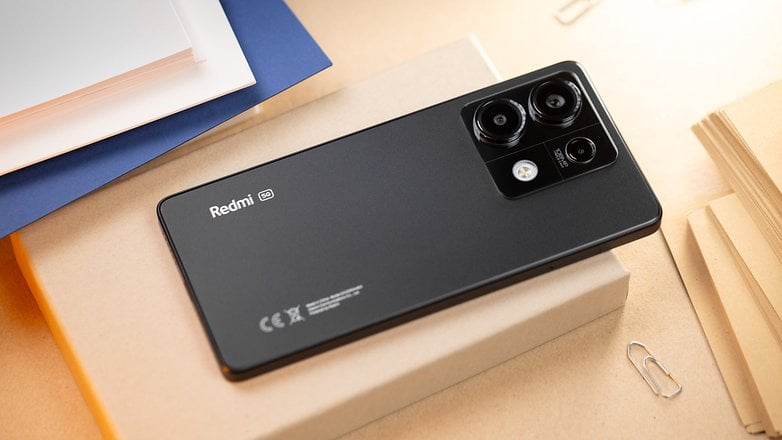
You have the choice between the 6 GB RAM and 128 GB storage space model with the 8 GB / 256 GB combination. If I were you, I would go for the latter, which retails for €299.90 since it is only €20 more expensive than the entry-level model at €279.90 a pop. Why is the denomination in €? Well, it is not sold in the US, that’s why! In selected regions, there is an even more advanced version with 12 GB RAM.
Design and display
The Xiaomi Redmi Note 13 5G feels good despite its plastic body and offers us a 6.67-inch AMOLED display with FHD+ resolution and a 120 Hz refresh rate at the front. At the back, there is a triple camera configuration in a revised, slimmer design that absolutely loves your fingerprints.
Pros:
- Powerful 120 Hz AMOLED display.
- Slim bezels.
- Gorilla Glass 5 display protection
- Housing looks high-quality despite the plastic used.
- 3.5 mm jack is available.
- Comes with a silicone protective cover.
Cons:
- The back is quite susceptible to fingerprints.
What caught my eye immediately was the camera island on the Redmi Note 13 5G which is not as bulky as we were used to from Xiaomi’s mid-range devices. There is still this elevated array that surrounds all three sensors and the flash, but it is more inconspicuous. Two cameras continue to stand out more than the rest, which is a visual cue that I like.
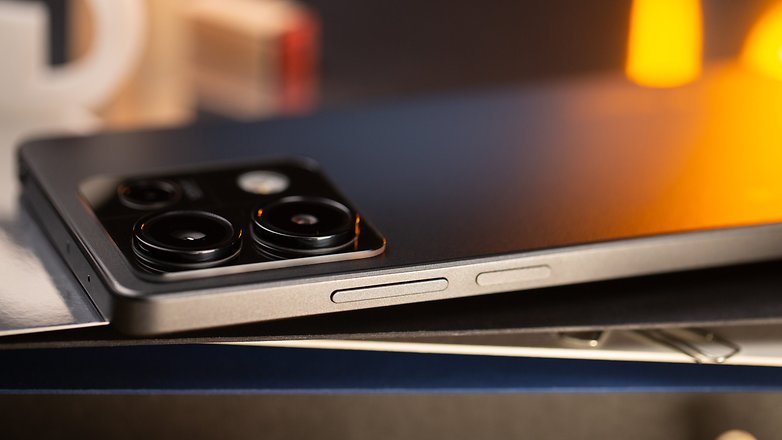
The smartphone is also slim, which makes the device great to hold. With my huge hands, I can easily reach the power button and the volume rocker above it on the right. However, I could imagine that you might run into difficulties with smaller hands.
While we’re at it, let’s take a look around the device: On top, you can insert a 3.5 mm plug for your wired headphones, and there is also an infrared sensor. On the left is a slot for either two SIM cards or one SIM card plus a microSD card. Finally, at the bottom, we have the USB-C port and the “unfortunately singular” mono speaker.
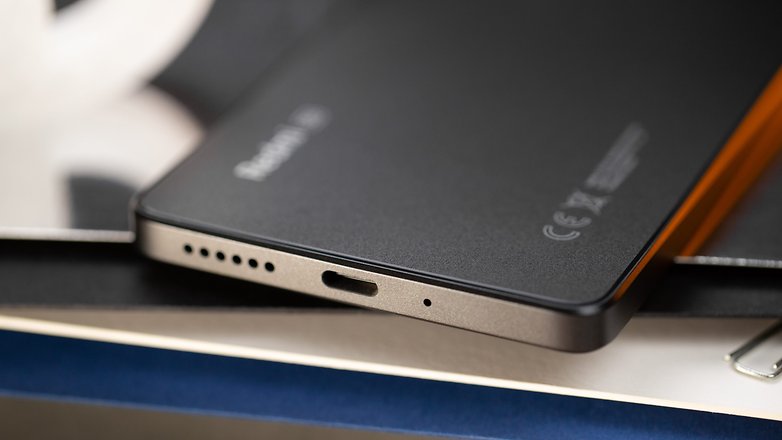
The device is splash-proof based on the IP54 rating. Yes, it could be improved, but at least it is IP-certified, and IP54 better than nothing for a phone in this price range. Incidentally, I can make out marks from my greasy fingers on my black matte model (there are also “Arctic White” and “Ocean Teal” colors). While it is not as obvious as a glossy back, but it is still visible.
Interestingly, the fingerprint sensor is located on the side of the power button. This is interesting because Xiaomi was able to integrate the fingerprint sensor into the display of the Redmi Note 13 LTE model which is €100 cheaper. However, I didn’t want to list this as a disadvantage because the sensor worked reliably on the Redmi Note 13 5G.
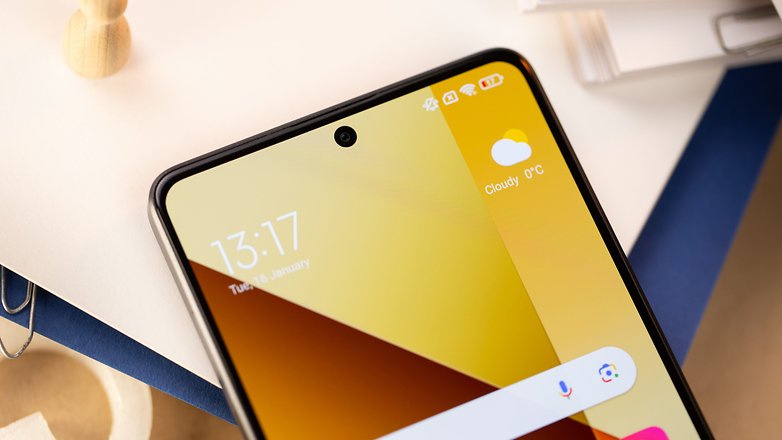
The display features a 6.67-inch display and FHD+ resolution that impressed me—hashtags: #AMOLED #120Hz. However, I am a little annoyed that it comes with a default 60 Hz refresh rate, and you have to go to the display settings if you want to experience the buttery-smooth 120 Hz. It is also pleasing that Xiaomi shaved off a bit of the bezels, making the slimmer edges look more modern.
At 500 nits of brightness, the panel is not the brightest. By the way, I was still able to read it clearly at all times during my rounds through the city on sunny winter days.
Software: “Hyper” my ass …
Xiaomi hasn’t underperformed here, but I’m still disappointed because MIUI 14 is loaded instead of
HyperOS which is based on
Android 13 instead of
Android 14. Fortunately, I was spared from another disappointment: all the bloatware still remained, of course.
Pros:
- Highly customizable Android skin.
Cons:
- Comes with Android 13.
- Lots of bloatware.
For those who didn’t recognize it: Yes, of course, my feigned enthusiasm above concerning bloatware was dripping with bitter cynicism. It’s always amazing how full of bloatware such a brand-new mid-range smartphone from Xiaomi comes with. However, when I saw the numerous pre-installed apps, I was already prepared for an even bigger disappointment. When I booted the phone up for the first time, I saw a MIUI logo where I would have loved to see a HyperOS logo instead.
What does this mean for you? Although Google will probably give us a foretaste of Android 15 at Google I/O (most likely in May), Xiaomi still gives us Android 13. To be honest, I don’t really feel like telling you for the umpteenth time about the software, where you would likely know all about anyway. However, take a look at our articles concerning MIUI 14 (review) or the best tips and tricks for MIUI on your Xiaomi smartphone.
Were you also hoping that HyperOS would already be available on the Redmi Note 13 series? If so, please be patient. The new operating system version, which is based on Android 14, should at least find its way to the Redmi Note 13 5G this year… Yes, I know, that’s a strange announcement to make so early in January. Xiaomi also guarantees another major update so that you can also enjoy Android 15 on this phone without any issues. Security updates will be available for a year longer.
Performance
The Redmi Note 13 5G is powered by the MediaTek Dimensity 6080, which performed quite well in everyday use for its price range without really impressing anyone.
Pros:
- Adequate performance under normal operating conditions.
- 5G.
Cons:
- Rather mediocre performance according to benchmark tests.
- Wi-Fi 5 only.
Out of habit, I always installed Genshin Impact and a racer (Asphalt 9 in this case) on my smartphone for reviews. Unsurprisingly, the Redmi Note 13 5G, which is powered by the MediaTek Dimensity 6080, drops frame rates if you were to opt for the highest graphics settings. However, if you lower the demands and graphics settings a little, you will be able to enjoy gaming with Xiaomi’s affordable mid-range.
I had nothing to complain about its performance in everyday use. Apps launched smoothly and there is generally no lag, meaning the Xiaomi Redmi Note 13 5G is more than suitable for everyday use for most normal users. Personally, I have the feeling that the performance far outperformed the benchmark tests.
| Redmi Note 13 5G (Dimensity 6080) |
Redmi Note 13 Pro 5G (Snapdragon 7s Gen 2) |
Motorola Edge 30 Neo (Snapdragon 695) |
Galaxy A54 (Exynos 1380) |
Redmi Note 12 Pro+ (Dimensity 1080) |
Redmi Note 13 Pro 4G (Helio G99 Ultra) |
|
|---|---|---|---|---|---|---|
| 3D Mark Wild Life | 1,328 | 3,050 | 1,205 | 2,847 | 2,273 | 1,245 |
| 3D Mark Wild Life Stress test |
Best loop: 1,333 Worst loop: 1,307 |
Best loop: 3,050 Worst loop: 2,754 |
Best loop: 1,208 Worst loop: 1,109 |
Best loop: 2,840 Worst loop: 2,804 |
Best loop: 2,281 Worst loop: 2,268 |
Best loop: 1,245 Worst loop: 1,217 |
| Geekbench 6 | Single: 777 Multi: 1,996 |
Single: 889 Multi: 2,523 |
Single: 889 Multi: 2,523 |
Single: 1,022 Multi: 2,889 |
Single: 965 Multi: 2,408 |
Single: 744 Multi: 2,112 |
| PCMark Work 3.0 | 10,582 | 13,047 | Not reviewed | 13.477 | 11,855 | 10,688 |
Our editorial story on the best smartphones under $300 is the Motorola Edge 30 Neo. A look at the table reveals how the Redmi phone performs better in 3D Mark tests, but lags in the Geekbench 6 test. The gap with the Redmi Note 13 Pro 5G (review), which my colleague Rubens recently took a closer look at, is noticeably larger. If you were to look at the 4G version of the Pro model, which is equipped with the Helio G99 Ultra, the Redmi Note 13 5G is pretty much on par.
You have the choice between 6 and 8 GB of RAM and the obligatory choice between 128 and 256 GB of expandable memory. I can’t tell you why the 12 GB version didn’t make it to Europe, but that would naturally price the device out of the sub-$300 range.
In terms of connectivity, it should also be mentioned that NFC and 5G are included. I am pleased about Bluetooth 5.3 included, and I am only a little disappointed that the smartphone supports the Wi-Fi 5 standard.
Camera
The triple camera configuration is almost obligatory on any affordable Xiaomi phone and the Xiaomi Redmi 13 5G offers a similar trinity. The main camera features 108 MP resolution, while the 8 MP ultra-wide camera and 2 MP macro camera are much less spectacular. You can take very decent selfies with a 16 MP front-facing camera though.
Pros:
- Beautiful 108 MP main camera.
- Useful selfie shooter.
Cons:
- Forget about ultra-wide angle photos at night.
- Let’s just never talk about 2MP macro cameras again.
I already mentioned the macro camera right above this sentence, and yes, that’s all I have to say about it. For all I care, Xiaomi can forget about this sensor and use the money saved to put a “Nobody needs 2 MP macro cameras” sticker in the box in the next generation.
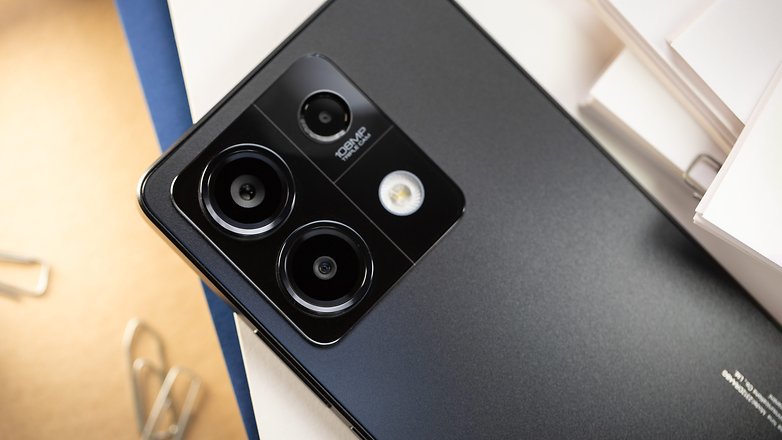
Let’s keep talking about the real cameras, and yes, the 108 MP main camera IS a real camera! This is especially stark during the day, and there’s nothing to complain about. I managed to take some great winter wonderland pictures while reviewing it. If you like, you can switch to 108 MP mode, but to be honest: pixels pieced together with 9-to-1 pixel binning produce completely decent results.
In the evening, of course, things start to slow down especially if you deactivate the auto night mode which is active by default. With night mode, the noise is manageable, and the halos also seem a little too large to me, but it is clearly better than if you captured photos without night mode.
Xiaomi Redmi Note 13 5G sample photos
What night owls among you should definitely forget: Taking photos with the ultra-wide angle camera. The 8 MP shooter really plays its cards close to its chest and creates a crude mix of image noise and blurred light sources. But hey, we’re playing in the €300 league, where viewers buy their season tickets for the main camera, not for an 8 MP ultra-wide angle or even a 2 MP macro camera.
What else do you need to know about the camera? Xiaomi did mention a lossless 3x zoom and indeed, the 3x zoom is absolutely fine. You can digitally zoom in on the object up to 10x, but the quality of the result decreases significantly, as expected. We should also mention the front camera, which does what it is supposed to with 16 MP and also has a portrait mode that produces good results. In my review of the camera to date, the foreground and background were precisely separated.
Battery
Xiaomi also plays its biggest mid-range hits with the battery: 5,000 mAh capacity, 33 W charging speed, and a charger is included.
Pros:
Cons:
I’m not keeping a secret here: reviews of Xiaomi’s mid-range devices are not always exciting to write. The software somehow looked like it did from the previous year, the design language has once again remained similar, an AMOLED display and a 120 Hz refresh rate are just as familiar a combination as the camera triumvirate. This also applies to the battery, which charges at 33 W, has a 5,000 mAh capacity, does not support wireless charging, and the charger is still included in the box.
So let’s tick that off and look at the results of the benchmark test:

The 11 hours and 16 minutes as determined in the test is decent, but nothing to be proud of at Xiaomi. As mentioned, the combination of 33 W charging and a 5,000 mAh capacity is a common one, and the Poco X5 5G (review) from last year, for instance, lasted an hour longer according to the test.
Nevertheless, I am not listing the battery life or the additional 33 W at the top of the list of cons. This is because we’re still talking about a very cheap smartphone and Samsung doesn’t even include the power adapter with a Galaxy S24 (hands-on) that’s three times as expensive and charges more slowly than the Redmi Note 13 5G.
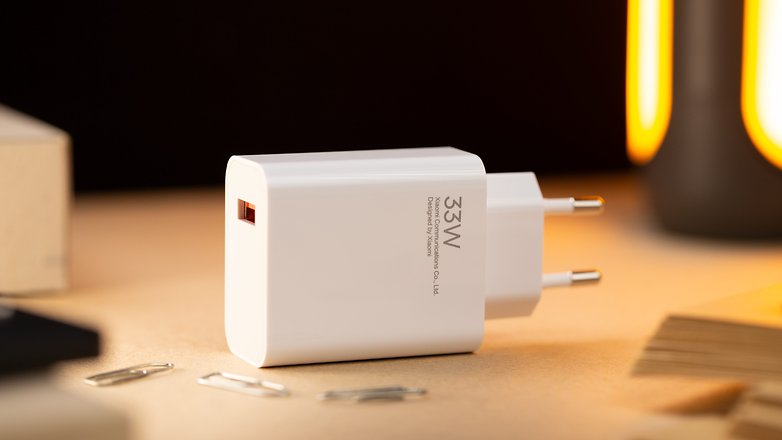
It is a shame that there is no wireless charging support or even reverse wireless charging, but this is standard in this price category. The only thing left to mention is that just over ten minutes of charging is enough to bring the device back up to 25 percent. In slightly more than an hour, the 100 percent indicator will flash in the top right-hand corner of the display.
Technical specifications
| Xiaomi Redmi Note 13 5G | |
|---|---|
| Image |  |
| Price (RRP) | |
| Display |
|
| SoC | |
| RAM |
|
| Memory |
|
| OS |
|
| Camera |
|
| Selfie camera | |
| Battery capacity |
|
| Connectivity |
|
| IP certification | |
| Dimensions and weight |
|
| Offers* |
|
Conclusion
I love my job. I really do! But you simply shouldn’t expect me to paint a smartphone like the Redmi Note 13 5G in glowing terms for your mind’s eye and pretend that I’m enthusiastically clicking my tongue in the face of an amazing piece of innovative engineering.
Instead, the box, which is really neat, can be described with three words: “cheap, generic, good”. This is because Xiaomi has once again assembled a smartphone that is easily sufficient for 95 percent of all smartphone users, looks nice, and is also inexpensive with a price tag starting at €279.
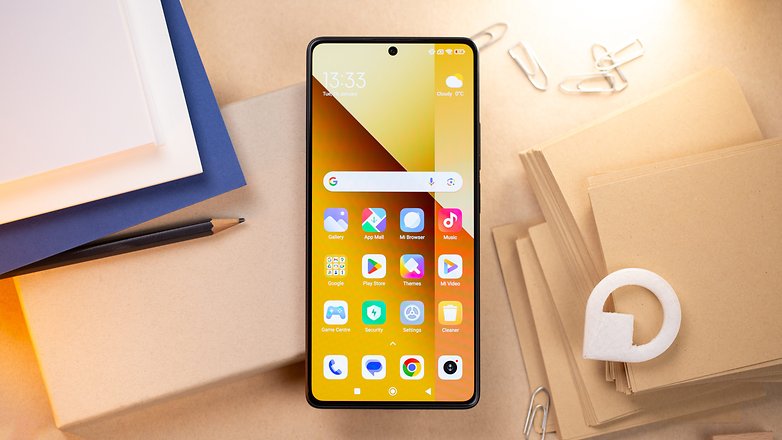
However, it still looks a bit like a generic Xiaomi smartphone:
- “Hey, give me a 120 Hz display, a 5,000 mAh battery, and a decent main camera”
- “Yep, I’ll do that! What about the other cameras? Can I put a 2 MP sensor as well? There are still so many of them flying around here!”
- “Macro? Sure, give it to me, people love it. Why not throw me a plastic case while you’re at it!”
Okay, it probably doesn’t work exactly like that…but it comes close!
Honestly speaking, what else should Xiaomi do? For just under €300, you get a smartphone with a great display and decent battery life that has a good camera and an okay processor on board. To be honest, I would have liked to see at least Android 14 onboard and maybe little things like stereo speakers or Wi-Fi 6 support. However, you know what? The Redmi Note 13 Ultra 5G still gets four stars from me. This is because it simply doesn’t make any significant mistakes and is a really great, everyday smartphone.
[ad_2]
Source link

























